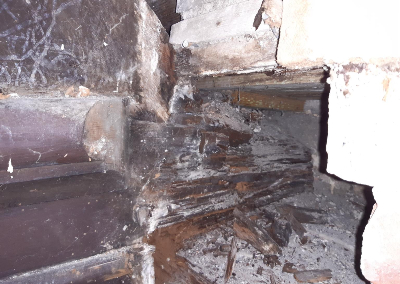Fungal decay, commonly known as wood rot, poses a significant threat to the structural integrity and safety of buildings. As experts in building preservation and restoration, Cannon Clarke Ltd recognises the critical importance of properly diagnosing the reasons for outbreaks of fungal decay and understanding the different types of rot to effectively treat and prevent further damage.
Importance of Proper Fungal Decay Diagnosis
Identifying Root Causes: Proper diagnosis allows us to identify the underlying factors contributing to fungal decay, such as moisture ingress, inadequate ventilation, or structural defects. By addressing these root causes, we can prevent future outbreaks and ensure long-term building preservation.
Tailored Treatment Solutions: Different types of rot require different treatment approaches. Without accurate diagnosis, there is a risk of applying ineffective or inappropriate treatments, leading to wasted time and resources. Proper diagnosis enables us to tailor our solutions to the specific type and extent of fungal decay present in the building.
Preventing Recurrence: Inadequate diagnosis may result in only addressing the visible symptoms of fungal decay, leaving underlying issues unresolved. This can lead to recurrence of the problem, requiring costly re-treatments and potentially exacerbating damage over time. Proper diagnosis is essential for implementing effective preventive measures to stop fungal decay from reoccurring.
Types of Wood Rot
Dry Rot (Serpula Lacrymans): Dry rot is a destructive form of fungal decay that thrives in damp, poorly ventilated environments. It can spread rapidly through timber, causing extensive damage to structural elements of buildings. Symptoms include deep cracking, cuboidal fractures, and a distinctive musty odour.
Often characterised by the decomposition of cellulose and hemicellulose in wood, resulting in a darkening and shrinking of the affected timber. Brown rot fungi are adept at breaking down the structural components of wood, leading to significant loss of strength and integrity.
Wet Rot: Wet rot is caused by various species of fungi that thrive in wet conditions. Unlike dry rot, wet rot requires higher levels of moisture to proliferate. It typically affects timber with high moisture content and can lead to softening, discolouration, and decay of wood.
How Cannon Clarke Can Help With Fungal Decay Solutions
Properly diagnosing outbreaks of fungal decay in buildings is paramount for effective treatment and prevention. Cannon Clarke Ltd emphasises the importance of thorough assessment and understanding the different types of rot to tailor solutions that address the root causes and mitigate further damage. By prioritising accurate diagnosis and targeted treatment strategies, we are committed to preserving the structural integrity and longevity of buildings for generations to come.


